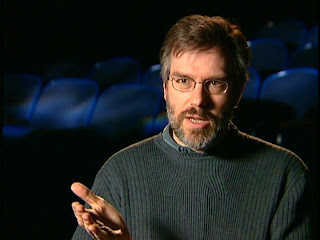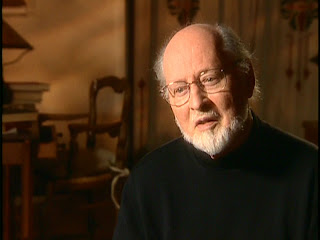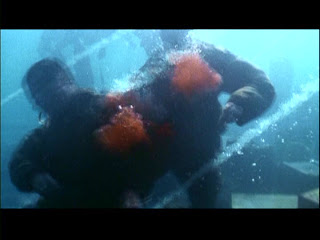


One of my classmates recommended that I watch a short piece interviewing John Williams and Gary Rydstrom about the making of the music and sound on the Saving Private Ryan DVD. In a short piece they both explained important elements central to the research of our group this semester.
John Williams has worked with Steven Spielberg on most of his films. When working with Spielberg, he prefers to see the film in its final stages rather than read the script ahead of time. For 'Ryan' Spielberg and Williams agreed not to use music during the battle scenes, but rather to keep them realistic. Williams wanted to focus on moments where the music would strike an emotional chord. For this, a choir was integral to the orchestra. Williams worked with the Boston Symphony Orchestra in the Boston Symphony Hall. As a side note, this particular music hall is one of the favorites of our guest, Tom Holman, who revers the acoustics in the Boston Symphony Hall as 'one of the great music halls in the world.' One thing I found interesting was in Williams' description of the Hymn to the Fallen which is the piece that closes the film. He said that it was a requiem for the people lost in the war. Often Williams composes for films by starting with the ending piece and then separating the ending and having threads of the ending running throughout the film. The threads of the music collect in the ending.
Gary Rydstrom has often been discussed in our research for creating the roars in Jurassic Park. However, I think 'Saving Private Ryan' is interesting for our research because he had to achieve a degree of realism so the film could be true to the memories of the people who were in it. He loved the opportunity to work on a war film that didn't have music in the battle scenes. Rydstrom asserts that anytime there is a score in a film, the audience feels like they're watching a movie. Without a score dominating the battle scenes, he was able to craft the scenes to be much more visceral. For example, the opening battle scene on Omaha Beach 'pulls you in and has you experience the battle in a very direct way.' Sound design guides the visceral experience. Spielberg told Rydstrom that he didn't want the sound to 'be Hollywood.' Rydstrom explains that this meant not using existing sound libraries, cliches, cheats, etc. This required the sound designer to do research by studying guns and weaponry and interviewing veterans to hear their experiences of the war and what it sounded like. He was surprised to learn how much of their memories were driven by the sounds of the battlefield. For example, the Germans listened for a particular 'ping' that came from ejecting an empty shell cartridge from an American gun. The Americans simulated these 'pings' to lure the Germans out from hiding. Through these 'revelatory' interviews, Rydstrom became passionate about achieving sound design that was true to their memories.
In the beginning of the film, in the Omaha Beach scene, Rydstrom wanted to recreate the experience of being shot at. For this scene he broke the scene into important elements. The most important elements were bullet impacts. For the pre-mix of the bullet impacts he had cue sheets stacks thick as phonebooks.
The Omaha Beach scene contains moments in the water where the camera bobs above and under water. Rydstrom took the opportunity to create contrasting perspectives above and underwater. Above water the battle rages and Rydstrom describes it as ' chaos and cacophony.' Underwater the cacophony goes away and the water becomes safe, like a cocoon. By placing these two perspectives in contrast, Rydstrom is able to unsettle the viewer when bullets pierce into the cocoon and kill the soldiers. For the sound of bullets piercing underwater, Rydstrom demonstrates using an un-horrific sound for horrific effect. He used the sound of a fly-fishing line being ripped out of the water, which he had saved from A River Runs Through It.
In terms of Sound and Consciousness, Rydstrom discusses scenes where Tom Hanks' character becomes shell-shocked. In these scenes, amidst the battle, the sound is taken out of the battle into Tom Hanks mind, creating an abstract expression and a window into the traumatic state of mind. According to Rydstrom, 'Taking the sound out of the battle became an interesting device to get inside someone's head.' Rydstrom had to imagine what it would be like to hear the sound of yourself. He remembered the experience of listening to a sea shell. "What you hear is an echo of the world around you, roaring in your head." To simulate this, Rydstrom recorded sounds of the ocean, then played them through speakers and re-recorded them by placing the microphone inside a long tube. This made 'a resonant shell sound.' Furthermore, Spielberg had the brilliant idea to conclude the interior experience with a high-pitched tea whistle that zapped the viewer back into reality. This proved to be really effective. In the final battle, the sound design returns to the effects of shell shock for Tom Hanks' character. Rydstrom manipulates the perspective in order to let the viewer see through this character's eyes. This effect allows us to identify with this character even more.
In the final battle, German tanks approach the few American troops still alive in the French town. During the night, they hear quiet, distant rumbling, like distant thunderstorms, from battles being fought miles away. Again, Rydstrom had to do research to achieve the effect he wanted. He found real recordings of World War Two battles and discovered they had the 'storm' quality to them. When he added the final layer of this distant rumble, he felt he had achieved a sense of reality and depth with the intricacy of the war in close perspective and also the sounds of the war on the horizon. This consciousness of sound delivers a profound sense of the scale of this war. Furthermore, in the final battle, the sound design changed to build on the tension the soldiers felt as the tanks approached, rather than the plunging in we experience of the Omaha Beach scene. For some time as they wait, we only hear the tanks approach. Spielberg referenced the film Zulu and required Rydstrom to study a particular scene where the Zulu warriors encroach on a British fort. Spielberg didn't want a copy of that sound, but he wanted the sound design to capture the feel and the essence of it. When the tanks arrive, Rydstrom created the sound of the tank wheels, squeaking and churning all from scratch. He played a selection of random sounds on 1/4 in. tape and reversed and slowed the sounds to create wild echoes simulating the clanging, rumbling tank bodies.
Studying Gary Rydstrom's work in 'Saving Private Ryan' directly to relates to Bill Whittington's research on sound design. All of the methods and philosophies of sound designers like Walter Murch are present in Gary Rydstrom's research, techniques, and thematic attention to detail. John Williams music for the film is also a great compliment to the presentation given by our guest Ken Hall. The music is selectively used to generate elegant moments of reverence and retrospection.
1 comment:
This was certainly very interesting. What I found remarkable was the comment about how the moment we add a soundtrack we start to feel we are watching a movie. I never thought about it but I actually completely agree. A battle scene with no music is definitely a lot rawer and has a touch of realism to it too. I find that when a track is added to a battle scene or something visually heavy like that we are taken out of it and respond more to the mood of the music, it becomes more of an emotional response, but a distant emotion, whereas watching a battle scene with no sound track that emphasizes all those visual nuances through sounds effects has a way of provoking more of a physical sensory response which is much better suited for a battle scene. We react physically which emphasizes the brutality of war and having a sound track we can start to react emotionally which is representative of the affects of war but not the actual act of it. It is real interesting how all these layers of sound can take and add to a film and the rest of the reading on how sound in the actual war itself was used strategically. What always fascinates me is how filmmakers and sound designers need to constantly relearn “listening” when it is such an integral part of our lives. I guess that’s what sound consciousness is all about.
Post a Comment